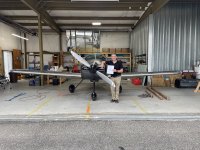Well as some of you know I have been working towards my CFI and started last summer with my instrument rating, December was Commercial, and this month I finally took and passed my CFI initial on the first attempt.
Now many people have done this before but I just wanted to say how thankful I am for these RV aircraft because I did every one of those check rides in the RV-7A I built. Thanks to Van's for building such a kick *** airplane! It's always fun to see the DPEs reactions to short field takeoffs vs the Cessnas they usually check ride in.
Hopefully this will motivate some of you to build on, trust me its worth it!
Now many people have done this before but I just wanted to say how thankful I am for these RV aircraft because I did every one of those check rides in the RV-7A I built. Thanks to Van's for building such a kick *** airplane! It's always fun to see the DPEs reactions to short field takeoffs vs the Cessnas they usually check ride in.
Hopefully this will motivate some of you to build on, trust me its worth it!





